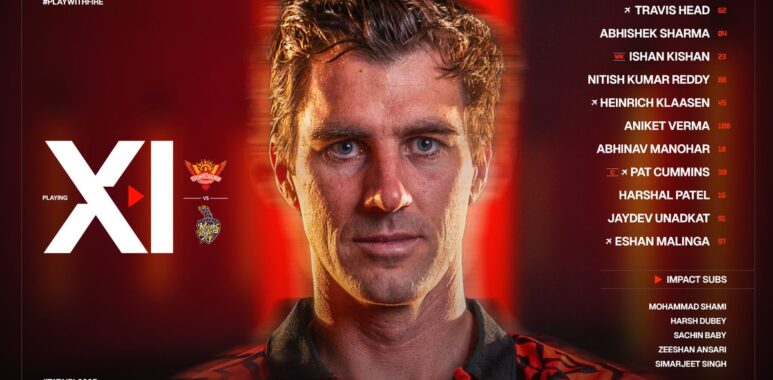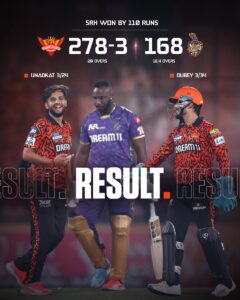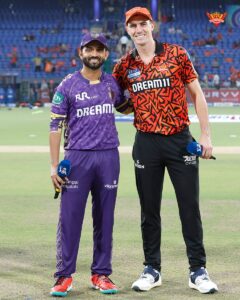
Sunrisers Hyderabad vs. Kolkata Knight Riders: A High-Octane Clash in IPL 2025’s 68th Match
On May 25, 2025, the Arun Jaitley Stadium in Delhi played host to the 68th match of the Indian Premier League (IPL) 2025, a thrilling encounter between Sunrisers Hyderabad (SRH) and Kolkata Knight Riders (KKR). While both teams had already been eliminated from playoff contention, the match was anything but a dead rubber, as SRH delivered a masterclass in batting to secure a commanding 110-run victory, powered by Heinrich Klaasen’s record-breaking century and a dominant team performance. This article delves into the match’s key moments, standout performances, tactical nuances, and its broader implications for both franchises as they concluded their IPL 2025 campaigns.
 The Arun Jaitley Stadium, known for its batting-friendly pitches and short boundaries, lived up to its reputation as SRH posted a mammoth 278/3 in their 20 overs, the third-highest total in IPL history, all three of which belong to SRH. KKR, tasked with chasing 279, struggled to find momentum and were bowled out for 168 in 18.4 overs, handing SRH a resounding victory. The match, played under clear skies with no threat of rain, saw temperatures hovering between 30-32°C, creating ideal conditions for a high-scoring spectacle.
The Arun Jaitley Stadium, known for its batting-friendly pitches and short boundaries, lived up to its reputation as SRH posted a mammoth 278/3 in their 20 overs, the third-highest total in IPL history, all three of which belong to SRH. KKR, tasked with chasing 279, struggled to find momentum and were bowled out for 168 in 18.4 overs, handing SRH a resounding victory. The match, played under clear skies with no threat of rain, saw temperatures hovering between 30-32°C, creating ideal conditions for a high-scoring spectacle.
SRH captain Pat Cummins won the toss and elected to bat first, a decision that proved pivotal given the dew factor expected later in the evening and the venue’s history of favoring high scores. Despite KKR’s reputation as a formidable T20 unit, their bowling attack failed to contain SRH’s aggressive batting lineup, and their chase faltered against a disciplined SRH bowling effort led by Jaydev Unadkat, Eshan Malinga, and Harsh Dubey.
 The story of the match was undeniably Heinrich Klaasen’s breathtaking century, a 105* off just 39 balls that included nine sixes and seven fours, making it the joint-third fastest century in IPL history. Promoted to No. 3 after Abhishek Sharma’s dismissal, Klaasen wasted no time, racing to a 17-ball fifty—his fastest in T20 cricket—at a strike rate of 300. His ability to punish both pace and spin, particularly on a pitch offering little assistance to bowlers, was a testament to his adaptability and power-hitting prowess.
The story of the match was undeniably Heinrich Klaasen’s breathtaking century, a 105* off just 39 balls that included nine sixes and seven fours, making it the joint-third fastest century in IPL history. Promoted to No. 3 after Abhishek Sharma’s dismissal, Klaasen wasted no time, racing to a 17-ball fifty—his fastest in T20 cricket—at a strike rate of 300. His ability to punish both pace and spin, particularly on a pitch offering little assistance to bowlers, was a testament to his adaptability and power-hitting prowess.
Klaasen’s innings was built on a foundation laid by openers Travis Head and Abhishek Sharma, who powered SRH to 79/0 in the powerplay. Head, in scintillating form, scored 76 off 40 balls, including a 26-ball fifty, before falling to Sunil Narine in the 13th over. Abhishek contributed a quickfire 32 off 16 balls, setting the tone with aggressive strokeplay. Ishan Kishan, batting at No. 4, played a supporting role with a composed 40 off 29 balls, rotating the strike to allow Klaasen to dominate. The pair added a rapid 50-run partnership in just 20 balls, with Klaasen targeting KKR’s spinners and pacers alike. Aniket Verma’s late cameo of 12* off 6 balls, including a four and a six, ensured SRH finished with a flourish, reaching 278/3.
 Klaasen’s century was a masterclass in situational batting. As he noted post-match, his promotion to No. 3 was a tactical move to capitalize on the powerplay’s end or early middle overs, allowing him to counterattack if early wickets fell. “I’m a situation player… If we lose a wicket after the powerplay or just at the end, then I just go in,” Klaasen said. His ability to improvise against Narine’s spin and punish fuller deliveries with straight sixes highlighted his versatility and cemented his status as one of the IPL’s most dangerous finishers.
Klaasen’s century was a masterclass in situational batting. As he noted post-match, his promotion to No. 3 was a tactical move to capitalize on the powerplay’s end or early middle overs, allowing him to counterattack if early wickets fell. “I’m a situation player… If we lose a wicket after the powerplay or just at the end, then I just go in,” Klaasen said. His ability to improvise against Narine’s spin and punish fuller deliveries with straight sixes highlighted his versatility and cemented his status as one of the IPL’s most dangerous finishers.
KKR’s bowling unit, typically a strength with spinners like Sunil Narine and Varun Chakravarthy, had a forgettable outing. Vaibhav Arora started tightly but conceded 21 runs in his two overs, while Anrich Nortje’s pace was taken apart, leaking 30 runs in two overs at an economy of 15.00. Narine provided a brief respite, dismissing Head and conceding just one run in his 13th over, but Klaasen’s assault in his final over—back-to-back sixes to bring up SRH’s 200—undid his control. Chakravarthy, KKR’s leading wicket-taker with 17 scalps in the season, struggled to find his rhythm, and the absence of Rovman Powell and Moeen Ali left KKR’s attack short of variety.
 The pitch, described as having a slight grass covering that aided batting, offered little for bowlers, and KKR’s inability to find consistent lengths was costly. Andre Russell and Harshit Rana were also expensive, with the latter conceding 22 runs in two overs. The dew factor, which made gripping the ball challenging in the second innings, further compounded KKR’s woes.
The pitch, described as having a slight grass covering that aided batting, offered little for bowlers, and KKR’s inability to find consistent lengths was costly. Andre Russell and Harshit Rana were also expensive, with the latter conceding 22 runs in two overs. The dew factor, which made gripping the ball challenging in the second innings, further compounded KKR’s woes.
Chasing 279 was always a daunting task, but KKR’s batting lineup, featuring power-hitters like Sunil Narine, Andre Russell, and Rinku Singh, had the potential to make a contest of it. However, SRH’s bowlers, led by Unadkat and Malinga, struck early to derail the chase. Unadkat dismissed Ajinkya Rahane (5.3 overs), Quinton de Kock (6.5 overs), Rinku Singh (7.5 overs), and Andre Russell (7.6 overs) in quick succession, finishing with figures of 3/24. Eshan Malinga, SRH’s breakout star with 10 wickets in six games, removed Angkrish Raghuvanshi (12.2 overs) and Ramandeep Singh (13.5 overs), ending with 2 wickets, including the final blow to Harshit Rana. Harsh Dubey, the young spinner, was the pick of the bowlers with 3 wickets, exploiting the slowing pitch to trouble KKR’s middle order.
Despite the early collapse, KKR showed some fight through Manish Pandey (37 off 23 balls) and Harshit Rana (34 off 21 balls), who smashed three sixes in a late counterattack. Their efforts, however, were merely consolatory, as KKR were bowled out for 168 in 18.4 overs, with Malinga sealing the victory by dismissing Rana. The required run rate of 14.05 after the powerplay proved insurmountable, with SRH’s bowlers maintaining pressure through slower balls and clever variations.
SRH’s decision to promote Klaasen to No. 3 was a masterstroke, allowing him to face more deliveries and maximize his impact. Their aggressive approach in the powerplay, led by Head and Abhishek, capitalized on the flat pitch and short boundaries, setting a platform for the middle order to accelerate. KKR, on the other hand, struggled with their bowling plans, failing to adapt to the conditions or counter SRH’s relentless hitting.
Key individual battles shaped the match. Travis Head’s struggles against Vaibhav Arora (averaging 2 in prior encounters) were overcome through aggressive intent, though Arora’s early control hinted at KKR’s potential to strike. Jaydev Unadkat’s dominance over Sunil Narine (19 runs, three dismissals in five innings) continued, with Narine managing only a six and a four before falling to SRH’s bowling trap. The absence of Venkatesh Iyer, replaced by Manish Pandey due to injury concerns, weakened KKR’s middle order, which has been a persistent issue this season with a run rate of 7.8 in overs 7-16, the lowest in the IPL.
 SRH’s 110-run victory was a statement of intent, showcasing their batting depth and ability to dominate even in a non-consequential match. Pat Cummins, reflecting on the season, expressed satisfaction with the team’s late form despite missing the playoffs: “Amazing finish. Lot of things clicked in the last few games… We have the calibre, but we couldn’t play any worse in some parts.” The performances of Klaasen, Head, and emerging talents like Eshan Malinga (picked for INR 1.2 crore) bode well for SRH’s future, with Malinga’s electric fielding and bowling making him a potential retention candidate for IPL 2026.
SRH’s 110-run victory was a statement of intent, showcasing their batting depth and ability to dominate even in a non-consequential match. Pat Cummins, reflecting on the season, expressed satisfaction with the team’s late form despite missing the playoffs: “Amazing finish. Lot of things clicked in the last few games… We have the calibre, but we couldn’t play any worse in some parts.” The performances of Klaasen, Head, and emerging talents like Eshan Malinga (picked for INR 1.2 crore) bode well for SRH’s future, with Malinga’s electric fielding and bowling making him a potential retention candidate for IPL 2026.
For KKR, the loss capped a disappointing season. Despite their title-winning campaign in 2024, their 2025 run was marred by inconsistency, with only five wins in 13 games. Ajinkya Rahane’s captaincy showed promise, but the absence of key players and middle-order struggles (lowest average runs per wicket at 20.8) exposed vulnerabilities. Harshit Rana’s late flourish with the bat and Varun Chakravarthy’s season-long bowling consistency (17 wickets) offered some positives, but KKR will need to regroup for 2026.
The Arun Jaitley Stadium’s pitch, with its flat surface and short boundaries, was tailor-made for high-scoring games. The average first-innings score at the venue this season was 191, with recent matches seeing chases of 188 and 200 completed with ease. While spinners took 31 wickets at an economy of 8.9 compared to pacers’ 29 wickets at 10.3, SRH’s batsmen neutralized KKR’s spin threat effectively. The absence of rain and the presence of dew favored the chasing side, but KKR’s early batting collapse rendered this advantage moot.
 The match generated significant buzz on social media, with posts on X praising Klaasen’s “classic century” and SRH’s “unreal hitting.” Fans noted SRH’s ability to live up to their reputation for posting massive totals, with one user commenting, “SRH playing like they want to prove their 300-run statements.” Analysts highlighted Klaasen’s promotion as a tactical triumph and lauded SRH’s ability to adapt to Delhi’s conditions, with one describing the pitch as “binding superbly” due to slight grass cover.
The match generated significant buzz on social media, with posts on X praising Klaasen’s “classic century” and SRH’s “unreal hitting.” Fans noted SRH’s ability to live up to their reputation for posting massive totals, with one user commenting, “SRH playing like they want to prove their 300-run statements.” Analysts highlighted Klaasen’s promotion as a tactical triumph and lauded SRH’s ability to adapt to Delhi’s conditions, with one describing the pitch as “binding superbly” due to slight grass cover.
For SRH, the match was a reminder of their potential when their batting clicks. With players like Klaasen, Head, and emerging stars like Malinga and Harsh Dubey, they have a strong core to build around. The decision on whether to retain Mohammed Shami, who was rested for this match, will be crucial given his INR 10 crore price tag and age (35 by IPL 2026).
KKR, meanwhile, face a rebuilding phase. Their middle-order woes and reliance on Narine and Chakravarthy for bowling impact need addressing. The potential debut of Luvnith Sisodia and the return of Venkatesh Iyer could provide fresh impetus, but KKR must find consistency to reclaim their 2024 glory.
The 68th match of IPL 2025 was a fitting finale for SRH, who ended their campaign with a dominant display of batting and bowling prowess. Heinrich Klaasen’s century, supported by Travis Head’s aggression and a disciplined bowling effort, ensured SRH finished on a high, even if the playoffs remained out of reach. For KKR, the loss was a bitter pill, but moments of resilience from Harshit Rana and Manish Pandey offered hope for the future. As both teams look to IPL 2026, this match will serve as a reminder of SRH’s explosive potential and KKR’s need for consistency in a fiercely competitive league.

